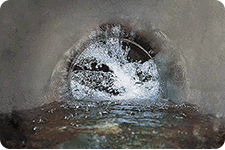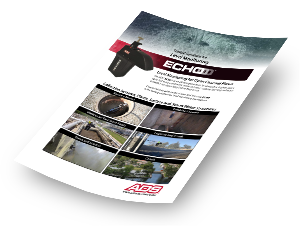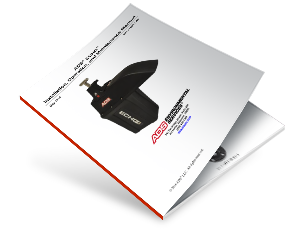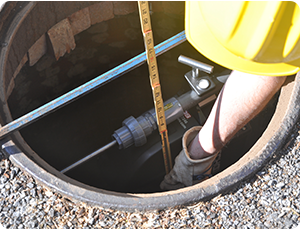ECHO
Jump to a Section: ECHO Applications | ECHO Resources | ECHO FAQs | ECHO Videos

The ADS® ECHO™ monitor provides utilities with an economical level monitoring solution providing early warning of preventable blockages; such as fats, oils, and greases (FOG); root intrusion; silt/sediment; and debris. The ECHO advances water and wastewater monitoring with higher levels of performance, a wider range of applications and lower acquisition and operating costs. Its patented, narrow-beam ultrasonic sensor provides users with up to 28 feet of manhole depth visibility (8′ above the sensor and 20′ below the sensor). The ECHO delivers consistent, quality data that is used for critical engineering, operations and maintenance applications.
For reliable connectivity, the ECHO now features communication via the LTE-M network which is designed and optimized for the Industrial Internet of Things (IIoT). The ADS ECHO utilizes StableSense™, an advanced mounting feature that secures sensor alignment near the top of the manhole. It eliminates issues associated with older, conventional ultrasonic sensor systems which are suspended on cables and prone to movement. StableSense assures users of acquiring consistent, high-quality data that also eliminates false alarms. Finally, to make informed decisions the ECHO’s cloud-based software and advanced analytics platform provides fast, easy access and exceptional insights into the collection system’s behavior.

Applications and Benefits
For hydraulic modeling, the ECHO captures remote site data in a cost-efficient manner, enabling wider deployment of sensors that can continuously feed and update hydraulic models.
For efficient sewer cleaning, the ECHO enables utilities to employ the latest cleaning practices. Continuous remote monitoring with advanced visibility assures that cleaning is performed only when needed.
For lift/pump station back-up, the ECHO adds redundancy for monitoring critical wastewater pump stations, eliminating power outages and pump concerns.
For SSO (Sanitary Sewer Overflow) mitigation, the ECHO uniquely provides 20 feet of visibility below the unit and up to eight feet above it. The ECHO always knows the water level in a manhole and provides multiple configurable alarms for advanced warning. The ECHO monitors bypass sites providing 24/7 protection against SSOs.
For obtaining CSO (Combined Sewer Overflow) data and reporting, the ECHO makes CSO reporting easier with automated data capture and reporting tools.
Download Datasheet // PURCHASE ON STOREFRONT
ECHO Resources
ECHO Resources
Literature
Product Manual
Setup Guides
Firmware and Software
Qualifying Locations
Literature

ECHO Literature
>> Download ECHO Product Literature
Product Manual

ECHO Product Manual
Installation, Operation and Maintenance
#QR7705031 A6 October 2022
>> Download ECHO Product Manual
Setup Guides

Guides to Set-up, Activate, Configure and Install Your ADS ECHO
>> ECHO Start-up Guide
Set up your ECHO before field Installation.
>> ECHO Quick Installation Guide
Step-by-step instructions for installing ECHO in the Field.
>> ECHO QstartXML Quick Reference Guide
Activate your ECHO before field installation.
>> Activation Instructions For Customer Using Their Own Verizon Wireless Network
Step-by-step instructions for ECHO activation when using your own Verizon wireless network.
Firmware and Software
Updates to Firmware and Software
All updates to ECHO firmware can be accessed through the ADS Software Downloads page. The ECHO is compatible with ADS’s PRISM advanced cloud-based software. Transform your level monitoring data into actionable insight when combining the ADS ECHO with PRISM. Always stay informed by regularly visiting the PRISM Updates page.
>>Software Downloads
>>PRISM
>>QstartXML
Startup and configuration software included with your purchase of the ADS ECHO.
>>Qstart
Legacy startup and configuration software included with your purchase of the ADS ECHO.
Qualifying Locations
Qualifying Locations
Qualifying monitoring locations in the collection system where the ADS ECHO monitor will be of value.
>>Application Notes: Qualifying ECHO Locations
ECHO FAQs
Q1. How is the pre-installed ADS SIM card activated?
A1. Activation instructions are found in the ECHO Qstart Quick Reference Guide. The contact point in ADS Customer Support is ADSEODIP@idexcorp.com. The activation will need to be requested within 48 hours of monitor installation.
Q2. What equipment is needed for initial setup of the ECHO™ monitor?
A2. The ADS Bluetooth dongle (P/N 9000-0061) and an ADS Blue Magnet (P/N 8000-0460) are needed to activate the ECHO monitor. These are available for purchase on the ADS Online Storefront.
Q3. What software is needed to setup the ECHO monitor?
A3. Both the Qstart software and an ADS Bluetooth dongle driver are needed, and are available for download on the ADS Software Downloads page. For further instructions regarding installing the Qstart software, download the Qstart Installation Guide, also on the software downloads page.
Q4. How can I get better signal from the Bluetooth dongle to the ECHO installed in the manhole, while keeping the computer a safe distance away from the manhole?
A4. Purchase a USB Extension Cable for the Bluetooth dongle. Refer to the “Increasing Bluetooth Dongle Signal Strength” section of Chapter 6 in the ECHO Installation, Operation, and Maintenance Manual.
Q5. Which version of Qstart should be used with the ECHO?
A5. The ECHO requires the use of Qstart 1.6 or higher. This software should be installed prior to proceeding with the Configuration and Activation steps and before going to the installation location.
Q6. How should the ECHO be configured and activated?
A6. All steps necessary for a successful configuration and activation of the ECHO are outlined in the ECHO Qstart Quick Reference Guide in the Configuration and Activation section of the document.
Q7. What is the Tilt alarm and how can the baseline be established?
A7. The Tilt alarm indicates that the monitor is out of position. The baseline can be established while online with the monitor in the Diagnostics tab of the Advanced device in Qstart by clicking the Set button to set the initial values after the monitor has been installed in the manhole. For further information on this process, consult Chapter 4 of the ECHO Installation, Operation, and Maintenance Manual.
Q8. What is the lowest High level alarm that can be set?
A8. The High level alarm can be set to as low as 2 inches (50mm).
Q9. What is the lowest Low level alarm that can be set?
A9. The Low level alarm can be set to as low as 2 inches (50 mm).
Q10. What is the smallest difference between High alarms and High High alarms that can be configured?
A10. The High High alarm must be configured to be at least 2 inches (50mm) greater than the High alarm. ADS recommends that this difference be greater.
Q11. What is the recommended default for setting High and High High alarms?
A11. ADS recommends the High alarm to be 24” (610 mm) over the top of the pipe and the High High alarm to be 36” (915 mm) below the top of the manhole.
Q12. How can the monitor be configured to send out alarms?
A12. The monitor can be configured to send out alarms through the Alarms and Data Delivery devices in Qstart. Further information on how to configure these devices is available in the ECHO Qstart Quick Reference Guide and the ECHO Installation, Operation, and Maintenance Manual.
Q13. Can the ECHO be configured to deliver data to ADS FlowView?
A13. Yes. The ECHO can be configured to deliver data to FlowView through the use of the Data Delivery device in Qstart. The server IP address is 64.14.232.177.
Q14. Can the ECHO deliver data simultaneously to an FTP server and FlowView?
A14. Yes, provided the Data Delivery device in Qstart has been configured to deliver data to both locations.
Q15. Why is the ECHO unable to deliver files to the FTP server after configuration?
A15. The folder name configured on the Data Delivery device cannot have spaces in the name. For example, ECHO Folder will not work, but ECHO_Folder will work. Verify that there are no spaces in the folder name and activate the ECHO again to see if it successfully delivers files to the FTP server. Other possibilities for this error could be that the FTP server is not configured to accept file delivery from the ECHO’s IP address, or that the ECHO is set to Active for delivery mode and needs to be set to Passive in the Data Delivery device. ADS recommends using Passive delivery mode.
Q16. What is the difference between Active and Passive mode on the Data Delivery device in the FTP setup section?
A16. The Active mode allows the monitor to set the data channel (port) for the FTP server to use; in the Passive mode, the FTP server tells the monitor which port to send the data over. Most servers are configured to accept data in the Passive mode only. Therefore, ADS recommends using this mode unless the FTP server does not support it.
Q17. Can the ECHO be configured to respond to on-demand requests and deliver data?
A17. Yes, provided the Modem Power is on. Further information regarding Modem Power Savings configuration can be found in the ECHO Qstart Quick Reference Guide and the ECHO Installation, Operation, and Maintenance Manual.
Q18. How can the ECHO be configured to notify users when an overflow is occurring?
A18. The Overflow alarm will need to be configured in the Alarms device in Qstart.
Q19. Does the ECHO installation require confined space entry?
A19. While OSHA Regulation 29 CFR 1910.146 defines “entry” as having occurred as soon as any part of the body breaks the plane of an opening into the confined space, installation of the ECHO does not require the installer to descend into the confined space.
Q20. What parts and tools are required for installing the ECHO?
A20. The following parts and tools are required: ECHO monitor, blue magnet, antenna, mounting bar, J-hook, rubber splicing tape, carpenter’s rule, and grade pole. If an external antenna is needed, additional tools will be required. Refer to Chapter 3 of the ECHO Installation, Operation, and Maintenance Manual or view the “How to Install an Antenna for use with ADS Monitors” video.
Q21. What resources are available for installing the ECHO?
A21. Each monitor has the ECHO Quick Installation Guide included in the box, which provides easy, step-by-step installation instructions. Also available is the “How to Install the ADS ECHO Level Monitor” video, which provides a detailed overview of the equipment needed and the steps required to install the monitor.
Q22. What are the mounting options for the ECHO monitor?
A22. The standard option for the ECHO monitor is using the Mounting Bar, which works for the standard manhole frame that is between 21 inches (533 mm) and 28 inches (711 mm) in diameter. Adding a single Mounting Bar Extension Rod (P/N 8000-0481) will work for frames between 28 inches (711 mm) to 36 inches (914 mm) and two extension rods will work for frames up to the size of 36 inches (914 mm) to 44 inches (1118 mm). The ECHO Quick Installation Guide covers this installation. For installations outside these parameters, the other option is the Wall Mount, which is detailed in Chapter 3 of the ECHO Installation, Operation, and Maintenance Manual.
Q23. How should the antenna be installed for proper communication?
A23. In almost all cases, it will be necessary to install the antenna external to the manhole. Refer to Chapter 3 of the ECHO Installation, Operation, and Maintenance Manual or view the “How to Install an Antenna for use with ADS Monitors” video for tools required and installation instructions.
Q24. Why is the ECHO not available for communication throughout the day? / Why has the ECHO stopped communicating?
A24. This is likely because the Modem is not on, or cellular communication has dropped off the network. The default manufacturer setting is for the modem power to be set to “Always Off.” Wait until 11AM – 12PM time frame (the modem is always on during this hour) to confirm communication has ceased. If the monitor still does not communicate, a field visit will be required to confirm the status using the LEDs. The Blue Magnet may be needed to reinitialize communication.
Q25. Can a user communicate directly with a deactivated ECHO?
A25. Once the monitor has been deactivated, users can no longer communicate with the ECHO remotely. In order to reinitialize communications, it must be activated again on-site using the Bluetooth dongle.
Q26. How long should the user hold the magnet to the monitor to initiate Bluetooth communications?
A26. The user should hold the magnet to the Wake activation point on the monitor between 3-5 seconds to initiate Bluetooth communication. The COMMS LED should show a deep blue flashing light, and the magnet should be removed after this occurs.
Q27. How long should the user hold the magnet to the monitor to initiate wireless connectivity and communications?
A27. The user should hold the magnet to the Wake activation point on the monitor between 25-30 seconds until the SENSE LED illumines magenta. Hold the magnet in place for another 1-2 seconds once this light illumines, then quickly remove the magnet. The SENSE light will begin to rapidly flash a green light and the COMMS LED will be a solid green until connected to the network. Once the COMMS light is slowly flashing green, wireless communications have been established.
Q28. How long will an ECHO battery last?
A28. Given the flexibility of the ECHO, the battery can last from 4 months to 4 years, depending on the configuration of Modem Power Settings, the frequency of the Data Delivery configuration, etc. When constant, on-demand communication is needed with frequent transmission of data, the battery life is approximately four months. When the Modem is set to Always Off and data is pushed daily, the battery life can exceed four years.
Q29. How can the battery life of the ECHO be maximized?
A29. Connect to the Monitor and select the Advanced function. Select Modem Power and update the modem power settings. The more time the modem is off, the more the battery life of the ECHO will be extended. The ECHO Qstart Quick Reference Guide and the ECHO Installation, Operation, and Maintenance Manual outline how to configure the Modem Power Parameters to conserve battery life.
Q30. What is the low battery threshold for the ECHO?
A30. The low battery threshold for the ECHO is 6.0 Volts. Once this threshold has been crossed, the battery will need to be changed within 1-2 weeks, depending on the communication configuration.
Q31. How can ADS Customer Support be contacted?
A31. ADS Customer Support can be contacted through email at adssupportcenter@idexcorp.com, or by telephone at 1-877-237-9585 (for U.S. customers) or 256-430-6234 (for customers outside the U.S.).
Q32. Is the ADS ECHO monitor considered Intrinsically Safe?
A32. Yes, the ECHO meets Intrinsic Safety standards through ATEX, IECEx, and CSA. For further information on this topic, view Chapter 1 of the ECHO Installation, Operation, and Maintenance Manual.
Q33. Can the ECHO calculate flow quantity?
A33. The ECHO itself does not calculate flow quantity, but FlowView® can calculate a depth-based quantity if the ECHO is configured to deliver data to FlowView. Contact ADS Customer Support to update the location information in FlowView to allow a depth-based quantity to be calculated.
Q34. How can the ECHO’s firmware be updated, and where can the firmware download be found?
A34. The firmware can be downloaded from the ADS Software Downloads page. For full instructions on upgrading the monitor’s firmware, view the Upgrading the Monitor Firmware section of Chapter 6 in the ECHO Installation, Operation, and Maintenance Manual.
Q35. Will the internal real-time clock of the ECHO drift?
A35. No. The internal clock of the ECHO is checked every 12 hours and compared to the cellular network time. If the internal ECHO clock differs by more than 5 seconds it is resynchronized to the cellular network time.
Q36. Are there resources for Maintenance and/or Troubleshooting issues with the ECHO?
A36. Chapter 6 in the ECHO Installation, Operation, and Maintenance Manual provides information on many topics regarding Maintenance and Troubleshooting.
Q37. What do the different flashing LED lights mean
A37. The LED interactions are outlined in Chapter 6 of the ECHO Installation, Operation, and Maintenance Manual. Some of the common indicators are as follows: a slow flashing green light on the COMMS LED indicates that the modem is connected to the wireless network; Rapidly flashing lights on the COMMS LED indicates that the ECHO is communicating, either delivering data, crying out an alarm, or being demand-polled; A yellow light on the SENSE LED indicates the monitor is awake and taking a reading.
Q38. Why is the ECHO reading a flat line depth
A38. There are two possible reasons for flat line depth data: 1) The monitor is likely oriented over the bench and not the invert. Adjust the orientation of the monitor to be positioned over the invert. 2) The ECHO is no longer level and is in TILT mode. When in TILT, UNIDEPTH will record the last valid LRDEPTH reading until it is returned to a level position.
Q39. The monitor appears to be alternating between reading the bench and the invert. How can this be corrected?
A39. The monitor is likely oriented partially over the bench and not completely over the invert. Adjust the orientation of the monitor to be over the invert.
Q40. My pressure data (PDEPTH_1) used to be a flat line equal to the manhole depth minus the physical offset of the ECHO installation. Now the pressure data varies reading to reading and the variation can be several inches at a time. The manhole is not surcharged. What causes this behavior?
A40. The ECHO battery is likely below the low battery threshold (6.0 volts). Replace the battery and the pressure data should return to accurately recording the installed position of the ECHO.
ECHO Videos
ECHO Videos
https://www.youtube.com/watch?v=Hwt7uCPnJe8
ECHO Installation and Maintenance Videos
How to Install the ADS ECHO Level Monitor
How to Replace a Battery Pack in an ADS ECHO Level Monitor
ECHO Configuration and Activation Videos
https://youtu.be/v1giDS0A0iU
Instructional Video: How to Configure and Activate the ADS ECHO with Qstart XML
https://www.youtube.com/watch?v=i7-iE1xrAOc
Overview of Updated QstartXML Software
https://youtu.be/Bl-pkc2z0WI
How to configure and activate an ADS ECHO with Qstart
Request Additional Information
Find Your Sales Contact
